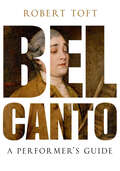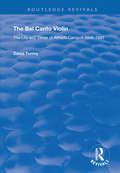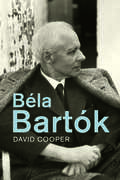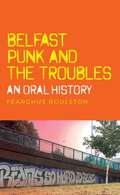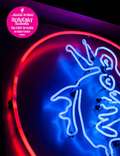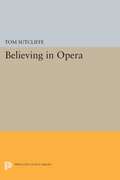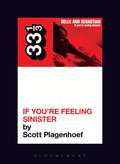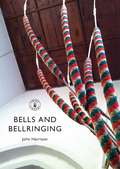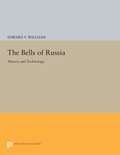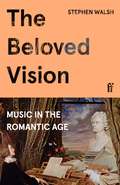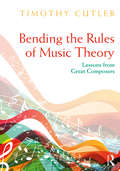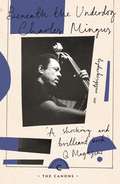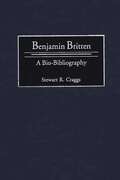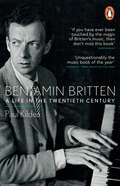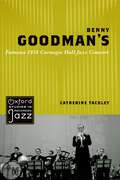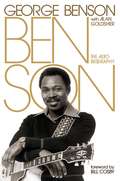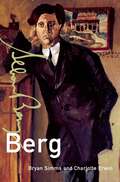- Table View
- List View
Bel Canto: A Performer's Guide
by Robert ToftBel canto, or 'beautiful singing,' remains one of the most elusive performance styles vocalists strive to master. During the eighteenth and early nineteenth centuries, composers routinely left the final shaping of recitatives, arias, and songs to performers, and singers treated scores freely so that inexpressively notated music could be turned into passionate declamation. In other words, vocalists saw their role more as one of re-creation than of simple interpretation. Familiarity with the range of strategies prominent singers of the past employed to unlock the eloquent expression hidden in scores enables modern performers to take a similar re-creative approach to enhancing the texts before them. In this first ever guide to bel canto, author Robert Toft provides singers with the tools they need not only to complete the creative process the composer began but also to bring scores to life in an historically-informed manner. Replete with illustrations based on excerpts from Italianate recitatives and arias by composers ranging from Handel to Rossini, the book offers discussions of the fundamental principles of expressive singing, each section including a practical application of the techniques involved. Drawing on a wealth of documents from the era, including treatises, scores, newspaper reviews, and letters, this book captures the breadth of practices singers used in the bel canto period. Complete with six scores (recitatives and/or arias) for performers to personalize through the old methods, and a companion website offering demonstrations of the principles involved, Bel Canto is an essential resource for any singer or vocal instructor wishing to explore and master historical techniques of interpretation and re-creation from the eighteenth and early nineteenth centuries.
The Bel Canto Violin: The Life and Times of Alfredo Campoli, 1906-1991 (Routledge Revivals)
by David TunleyFirst published in 1999, this biography from David Tunley draws on newly researched documentary evidence to chart Campoli’s early success and his later struggle for recognition as a serious artist. Campoli’s early success and his later struggle for recognition as a serious artist. Campoli’s career emerges as one particularly shaped and directed by the great economic and social forces of the first half of the century, and the story here is as much that of his times, as of his life. Described by Szigeti as ‘one of the last great individualists among violinists’, Alfredo Campoli was a household name in the field of British light music prior to the Second World War. Having made his début at the Wigmore Hall in 1923 Campoli toured with Melba and Butt, then turned to light music during the Depression. He became one of Decca’s early recording artists and broadcast frequently for the BBC with his light music ensembles and pursued a long, successful career as a distinguished international performer.
The Bel Canto Violin: The Life and Times of Alfredo Campoli, 1906-1991 (Routledge Revivals)
by David TunleyFirst published in 1999, this biography from David Tunley draws on newly researched documentary evidence to chart Campoli’s early success and his later struggle for recognition as a serious artist. Campoli’s early success and his later struggle for recognition as a serious artist. Campoli’s career emerges as one particularly shaped and directed by the great economic and social forces of the first half of the century, and the story here is as much that of his times, as of his life. Described by Szigeti as ‘one of the last great individualists among violinists’, Alfredo Campoli was a household name in the field of British light music prior to the Second World War. Having made his début at the Wigmore Hall in 1923 Campoli toured with Melba and Butt, then turned to light music during the Depression. He became one of Decca’s early recording artists and broadcast frequently for the BBC with his light music ensembles and pursued a long, successful career as a distinguished international performer.
Béla Bartók
by Prof. David Cooper"This deeply researched biography of Béla Bartók (1881–1945) provides a more comprehensive view of the innovative Hungarian musician than ever before. David Cooper traces Bartók’s international career as an ardent ethno-musicologist and composer, teacher, and pianist, while also providing a detailed discussion of most of his works. Further, the author explores how Europe’s political and cultural tumult affected Bartók’s work, travel, and reluctant emigration to the safety of America in his final years. Cooper illuminates Bartók’s personal life and relationships, while also expanding what is known about the influence of other musicians—Richard Strauss, Zoltán Kodály, and Yehudi Menuhin, among many others. The author also looks closely at some of the composer’s actions and behaviors which may have been manifestations of Asperger syndrome. The book, in short, is a consummate biography of an internationally admired musician."
Belfast punk and the Troubles: An oral history
by Fearghus RoulstonBelfast punk and the Troubles is an oral history of the punk scene in Belfast from the mid-1970s to the mid-80s. The book explores what it was like to be a punk in a city shaped by the violence of the Troubles, and how this differed from being a punk elsewhere. It also asks what it means to have been a punk – how punk unravels as a thread throughout the lives of the people interviewed, and what that unravelling means in the context of post-peace-process Northern Ireland. In doing so, it suggests a critical understanding of sectarianism, subjectivity and memory politics in the North, and argues for the importance of placing punk within the segregated structures of everyday life described by the interviewees.Adopting an innovative oral history approach drawing on the work of Luisa Passerini and Alessandro Portelli, the book analyses a small number of oral history interviews with participants in granular detail. Outlining the historical context and the cultural memory of punk, the central chapters each delve into one or two interviews to draw out the affective, imaginative and political ways in which punks and former punks evoke their memories of taking part in the scene. Through this method, it analyses the punk scene as a structure of feeling shaped through the experience of growing up in wartime Belfast.Belfast punk and the Troubles is an intervention in Northern Irish historiography stressing the importance of history from below, and will be compelling reading for historians of Ireland and of punk, as well as those interested in innovative approaches to oral history.
Belfast punk and the Troubles: An oral history
by Fearghus RoulstonBelfast punk and the Troubles is an oral history of the punk scene in Belfast from the mid-1970s to the mid-80s. The book explores what it was like to be a punk in a city shaped by the violence of the Troubles, and how this differed from being a punk elsewhere. It also asks what it means to have been a punk – how punk unravels as a thread throughout the lives of the people interviewed, and what that unravelling means in the context of post-peace-process Northern Ireland. In doing so, it suggests a critical understanding of sectarianism, subjectivity and memory politics in the North, and argues for the importance of placing punk within the segregated structures of everyday life described by the interviewees.Adopting an innovative oral history approach drawing on the work of Luisa Passerini and Alessandro Portelli, the book analyses a small number of oral history interviews with participants in granular detail. Outlining the historical context and the cultural memory of punk, the central chapters each delve into one or two interviews to draw out the affective, imaginative and political ways in which punks and former punks evoke their memories of taking part in the scene. Through this method, it analyses the punk scene as a structure of feeling shaped through the experience of growing up in wartime Belfast.Belfast punk and the Troubles is an intervention in Northern Irish historiography stressing the importance of history from below, and will be compelling reading for historians of Ireland and of punk, as well as those interested in innovative approaches to oral history.
Believe in Magic: 30 Years of Heavenly Recordings
by Robin Turner'Heavenly is more than a record label, it's the absolute nectar of all that's brilliant in the culture of these island. I love the shit out of them and everything they stand for.' Irvine WelshBELIEVE IN MAGIC tells the story of Heavenly Recordings in thirty vignettes, photography and ephemera, all of which relate to landmark records, moments and characters in the label's first three decades.A label responsible for creating satellite communities of fans around the world and at all the major festivals, Heavenly was set up by Jeff Barrett in 1990 after several years working for Factory and Creation as the acid house revolution was in full swing; early releases set the tone and tempo for the mood of the decade to come - their first single was produced by perhaps the most revered acid house DJ of them all, Andrew Weatherall; and this was quickly followed by era-defining singles from Saint Etienne, Flowered Up and Manic Street Preachers, music which perhaps captures the flavour of the early '90s better than any other.Heavenly was always tuned to an aesthetic that was sensitive to the anarchic spirt of the times; defiantly eclectic with a radar set to taste and a never-ending commitment to discovering new talent. In 1994 they set up The Heavenly Sunday Social, which became one of the most influential and mythologised clubs in recent British history, where the Chemical Brothers - then the Dust Brothers - made their name. For thirteen weeks, it was the hottest nightclub on the planet. For 180 demented acolytes in a basement room below the Albany pub.Over nearly 200 releases in thirty years Heavenly have consistently produced some of the most exciting music across all genres, and this book collects rare artwork and wild anecdotal evidence into a celebration of a label that is one of the most beloved institutions on the independent landscape.BELIEVE IN MAGIC includes contributions from Manic Street Preachers, Beth Orton, Doves, Don Letts, Edwyn Collins, Confidence Man, Mark Lanegan, King Gizzard and The Lizard Wizard.
Believing in Opera (PDF)
by Tom SutcliffeThe staging of opera has become immensely controversial over the last twenty years. Tom Sutcliffe here offers an engaging and far-reaching book about opera performance and interpretation. This work is a unique tribute to the most distinctive and adventurous achievements in the theatrical interpretation of opera as it has developed in recent decades. Readers will find descriptions of the most original and successful avant-garde opera productions in Britain, Europe, and America. Sutcliffe beautifully illustrates how updating, transposition, or relocation, and a variety of unexpected imagery in opera, have qualified and adjusted our perception of the content and intention of established masterpieces.Believing in Opera describes in detail the seminal opera productions of the last fifty years, starting with Peter Brook in London after the war, and continuing with the work of such directors and producers as Patrice Chéreau in Bayreuth, Peter Sellars and David Alden in America, Ruth Berghaus in Frankfurt, and such British directors as Richard Jones, Graham Vick, Peter Hall, and David Pountney. Through his descriptions of these works, Sutcliffe states that theatrical opera has been enormously influenced by the editing style, imagery, and metaphor commonplace in the cinema and pop videos. The evolution of the performing arts depends upon revitalization and defamiliarization, he asserts. The issue is no longer naturalism, but the liberation of the audience's imagination powered by the music.Sutcliffe, an opera critic for many years, argues that opera is theater plus music of the highest expressive quality, and as a result he has often sided with unconventional and novel theatrical interpretations. He believes that there is more to opera than meets the ear, and his aim is to further the process of understanding and interpretation of these important opera productions. No other book has attempted this kind of monumental survey.Originally published in 1997.The Princeton Legacy Library uses the latest print-on-demand technology to again make available previously out-of-print books from the distinguished backlist of Princeton University Press. These editions preserve the original texts of these important books while presenting them in durable paperback and hardcover editions. The goal of the Princeton Legacy Library is to vastly increase access to the rich scholarly heritage found in the thousands of books published by Princeton University Press since its founding in 1905.
Belle & Sebastian's If You're Feeling Sinister (33 1/3)
by Scott PlagenhoefIf You're Feeling Sinister shows how Belle & Sebastian transformed themselves over the space of a decade, from a slightly shambolic cult secret into a polished, highly entertaining, mainstream pop group. Along the way, the book shows how the internet has revolutionized how we discover new music-often at the cost of romance and mystery.
Belle & Sebastian's If You're Feeling Sinister (33 1/3)
by Scott PlagenhoefIf You're Feeling Sinister shows how Belle & Sebastian transformed themselves over the space of a decade, from a slightly shambolic cult secret into a polished, highly entertaining, mainstream pop group. Along the way, the book shows how the internet has revolutionized how we discover new music-often at the cost of romance and mystery.
Bells and Bellringing (Shire Library #802)
by John HarrisonHandel called Britain 'The Ringing Isle' because he heard bells ringing everywhere he went. Behind the quintessentially English sound of bells ringing lies a unique way of hanging bells and a special way of ringing them that evolved in the late sixteenth century. Ringing has since developed and spread, with some 6,000 towers worldwide with bells hung in the English style, and most of them in England. Over 40,000 active ringers keep alive the traditions and skills of change ringing that have been handed down over many generations.The book is an introduction to the world of bells and bell-ringing. It explains how bells are made and how a ringing installation works. It explains the nature of change ringing, which has mathematical as well as musical aspects. It provides insights into the ringing community its origins and culture as well as its relationships with the Church and the community.
Bells and Bellringing (Shire Library)
by John HarrisonHandel called Britain 'The Ringing Isle' because he heard bells ringing everywhere he went. Behind the quintessentially English sound of bells ringing lies a unique way of hanging bells and a special way of ringing them that evolved in the late sixteenth century. Ringing has since developed and spread, with some 6,000 towers worldwide with bells hung in the English style, and most of them in England. Over 40,000 active ringers keep alive the traditions and skills of change ringing that have been handed down over many generations.The book is an introduction to the world of bells and bell-ringing. It explains how bells are made and how a ringing installation works. It explains the nature of change ringing, which has mathematical as well as musical aspects. It provides insights into the ringing community its origins and culture as well as its relationships with the Church and the community.
The Bells of Russia: History and Technology
by Edward V. WilliamsThis generously illustrated book records the story of Russia's bells--the thousands of awe inspiring instruments that gave voice to the visual splendors of Russian Orthodoxy and to the political aspirations of the tsars.Originally published in 1986.The Princeton Legacy Library uses the latest print-on-demand technology to again make available previously out-of-print books from the distinguished backlist of Princeton University Press. These editions preserve the original texts of these important books while presenting them in durable paperback and hardcover editions. The goal of the Princeton Legacy Library is to vastly increase access to the rich scholarly heritage found in the thousands of books published by Princeton University Press since its founding in 1905.
The Beloved Vision: Music in the Romantic Age
by Professor Stephen WalshEveryone loves romantic music: the sweet melody of a Schubert song, the heroine dying for love in an Italian opera, the swooning orchestration of a Tchaikovsky symphony. But as Stephen Walsh - author of the highly praised Debussy: A Painter in Sound - points out in this intensely absorbing study, there is infinitely more to romantic music than meets the eye. The Most Romantic Art amounts to a complete, entertaining and singularly readable account of the whole phase in music history that has become the mainstay of the twentieth and twenty-first century concert and operatic repertoire, with some little help from earlier times. The narrative begins in the eighteenth century, with C.P.E.Bach, Haydn and the literary movement known as Sturm und Drang, seen as a reaction of the individual artist to the confident certainties of the Enlightenment. The windows are flung open, and everything to do with style, form, even technique, is exposed to the emotional and intellectual weather, the impulses and preferences of the individual composer. Risk taking - the braving of the unknown - was certainly an important part of what the composers wanted to do, as true of Chopin and Verdi as it is of Berlioz and Wagner. It's an exciting, colourful, story, told with passion but also with the precision and clarity of detail for which this author is so widely admired.
Bending the Rules of Music Theory: Lessons from Great Composers
by Timothy CutlerFor students learning the principles of music theory, it can often seem as though the tradition of tonal harmony is governed by immutable rules that define which chords, tones, and intervals can be used where. Yet even within the classical canon, there are innumerable examples of composers diverging from these foundational "rules." Drawing on examples from composers including J.S. Bach, Mozart, Beethoven, Schubert, Mendelssohn, Chopin, Brahms, and more, Bending the Rules of Music Theory seeks to take readers beyond the basics of music theory and help them to understand the inherent flexibility in the system of tonal music. Chapters explore the use of different rule-breaking elements in practice and why they work, introducing students to a more nuanced understanding of music theory.
Bending the Rules of Music Theory: Lessons from Great Composers
by Timothy CutlerFor students learning the principles of music theory, it can often seem as though the tradition of tonal harmony is governed by immutable rules that define which chords, tones, and intervals can be used where. Yet even within the classical canon, there are innumerable examples of composers diverging from these foundational "rules." Drawing on examples from composers including J.S. Bach, Mozart, Beethoven, Schubert, Mendelssohn, Chopin, Brahms, and more, Bending the Rules of Music Theory seeks to take readers beyond the basics of music theory and help them to understand the inherent flexibility in the system of tonal music. Chapters explore the use of different rule-breaking elements in practice and why they work, introducing students to a more nuanced understanding of music theory.
Beneath The Underdog: His World As Composed By Mingus (Canons #7)
by Charles MingusBass player extraordinaire Charles Mingus, who died in 1979, is one of the essential composers in the history of jazz, and Beneath the Underdog, his celebrated, wild, funny, demonic, anguished, shocking and profoundly moving memoir, is the greatest autobiography ever written by a jazz musician. It tells of his God-haunted childhood in Watts during the 1920s and 1930s; his outcast adolescent years; his apprenticeship, not only with jazzmen but also with pimps, hookers, junkies, and hoodlums; and his golden years in New York City with such legendary figures as Duke Ellington, Lionel Hampton, Miles Davis, Charlie Parker, and Dizzy Gillespie. Here is Mingus in his own words, from shabby roadhouses to fabulous estates, from the psychiatric wards of Bellevue to worlds of mysticism and solitude, but for all his travels never straying too far, always returning to music.
Benjamin Britten: A Bio-Bibliography (Bio-Bibliographies in Music)
by Stewart R. CraggsBenjamin Britten was arguably the greatest English composer of his time. His music crossed boundaries of genre and form to include opera, ballet, orchestral and chamber music, and film and incidental music. The result of twenty years of research, ^IBenjamin Britten^R provides up-to-date and comprehensive details about Britten's life and music, including works, performances, and recordings--an effort never before undertaken. Certain to be of use to any scholar of British music or 20th century composition, this reference work is an invaluable addition to the literature on this important artist.Following a brief biography of the subject, author Stewart Craggs provides a complete list of works and performances, arranged by genre; a discography, and an annotated bibliography. Rounding out the volume are two lists of compositions, one arranged alphabetically and the other chronologically, and a general index.
Benjamin Britten: A Life in the Twentieth Century
by Paul KildeaPublished to mark the beginning of the Britten centenary year in 2013, Paul Kildea's Benjamin Britten: A Life in the Twentieth Century is the definitive biography of Britain's greatest modern composer. In the eyes of many, Benjamin Britten was our finest composer since Purcell (a figure who often inspired him) three hundred years earlier. He broke decisively with the romantic, nationalist school of figures such as Parry, Elgar and Vaughan Williams and recreated English music in a fresh, modern, European form. With Peter Grimes (1945), Billy Budd (1951) and The Turn of the Screw (1954), he arguably composed the last operas - from any composer in any country - which have entered both the popular consciousness and the musical canon. He did all this while carrying two disadvantages to worldly success - his passionately held pacifism, which made him suspect to the authorities during and immediately after the Second World War - and his homosexuality, specifically his forty-year relationship with Peter Pears, for whom many of his greatest operatic roles and vocal works were created. The atmosphere and personalities of Aldeburgh in his native Suffolk also form another wonderful dimension to the book. Kildea shows clearly how Britten made this creative community, notably with the foundation of the Aldeburgh Festival and the building of Snape Maltings, but also how costly the determination that this required was. Above all, this book helps us understand the relationship of Britten's music to his life, and takes us as far into his creative process as we are ever likely to go. Kildea reads dozens of Britten's works with enormous intelligence and sensitivity, in a way which those without formal musical training can understand. It is one of the most moving and enjoyable biographies of a creative artist of any kind to have appeared for years. Paul Kildea is a writer and conductor who has performed many of the Britten works he writes about, in opera houses and concert halls from Sydney to Hamburg. His previous books include Selling Britten (2002) and (as editor) Britten on Music (2003). He was Head of Music at the Aldeburgh Festival between 1999 and 2002 and subsequently Artistic Director of the Wigmore Hall in London.
Benjamin Britten (Penguin Specials)
by Igor Toronyi-LalicBenjamin Britten was one of the most important and unusual figures in twentieth-century music. This is the perfect introduction to his many wonderful works and his fascinating, controversial life.Benjamin Britten single-handedly transformed the reputation of British classical music. The enormous popular appeal of his great works, such as Peter Grimes (1945) and the Young Person's Guide to the Orchestra (1946), make him the most successful opera composer of any born in the twentieth century. But his success was not without controversy and pain: he was accused of fleeing Britain to avoid military service, he was widely known to be sexually obsessed with boys and he suffered an astonishing array of illnesses. This short book combines a colourful overview of his life with pithy descriptions of all of his major musical works, providing an intimate portrait of this highly unusual man and a persuasive account of his influences, reputation and importance.Each chapter tackles a key episode and theme in his life, from his first compositions at the age of 5, his early friendship and collaboration with W H Auden and the beginnings of his life-long relationship with the tenor Peter Pears, through to his great musical successes and the establishment of the influential, if tempestuous, Aldeburgh Festival, as well as his failures, such as his coronation opera Gloriana (known as 'Boriana') and being satirised by Dudley Moore in Beyond the Fringe - and ending with frank discussions of his naïve politics, his troubling sexuality and his glorious musical legacy.Published to coincide with his 100th anniversary of his birth, this is the perfect introduction to a towering figure of British culture.Igor Toronyi-Lalic is a critic and curator. He writes regularly on music for, among others, The Times and Sunday Telegraph. He is a founder of theartsdesk.com, the author of What's That Thing? (2012), a report on public art, and co-director of the London Contemporary Music Festival.
Benny Goodman's Famous 1938 Carnegie Hall Jazz Concert (Oxford Studies in Recorded Jazz)
by Catherine TackleyOn January 16, 1938 Benny Goodman brought his swing orchestra to America's venerated home of European classical music, Carnegie Hall. The resulting concert - widely considered one of the most significant events in American music history - helped to usher jazz and swing music into the American cultural mainstream. This reputation has been perpetuated by Columbia Records' 1950 release of the concert on LP. Now, in Benny Goodman's Famous 1938 Carnegie Hall Jazz Concert, jazz scholar and musician Catherine Tackley provides the first in depth, scholarly study of this seminal concert and recording. Combining rigorous documentary and archival research with close analysis of the recording, Tackley strips back the accumulated layers of interpretation and meaning to assess the performance in its original context, and explore what the material has come to represent in its recorded form. Taking a complete view of the concert, she examines the rich cultural setting in which it took place, and analyzes the compositions, arrangements and performances themselves, before discussing the immediate reception, and lasting legacy and impact of this storied event and album. As the definitive study of one of the most important recordings of the twentieth-century, Benny Goodman's Famous 1938 Carnegie Hall Jazz Concert is a must-read for all serious jazz fans, musicians and scholars.
Benny Goodman's Famous 1938 Carnegie Hall Jazz Concert (Oxford Studies in Recorded Jazz)
by Catherine TackleyOn January 16, 1938 Benny Goodman brought his swing orchestra to America's venerated home of European classical music, Carnegie Hall. The resulting concert - widely considered one of the most significant events in American music history - helped to usher jazz and swing music into the American cultural mainstream. This reputation has been perpetuated by Columbia Records' 1950 release of the concert on LP. Now, in Benny Goodman's Famous 1938 Carnegie Hall Jazz Concert, jazz scholar and musician Catherine Tackley provides the first in depth, scholarly study of this seminal concert and recording. Combining rigorous documentary and archival research with close analysis of the recording, Tackley strips back the accumulated layers of interpretation and meaning to assess the performance in its original context, and explore what the material has come to represent in its recorded form. Taking a complete view of the concert, she examines the rich cultural setting in which it took place, and analyzes the compositions, arrangements and performances themselves, before discussing the immediate reception, and lasting legacy and impact of this storied event and album. As the definitive study of one of the most important recordings of the twentieth-century, Benny Goodman's Famous 1938 Carnegie Hall Jazz Concert is a must-read for all serious jazz fans, musicians and scholars.
Benson: The Autobiography (Piano-vocal-guitar Ser.)
by George Benson Alan GoldsherOver the course of his fifty-year career, George Benson has performed for hundreds of millions of fans around the world, received ten Grammy Awards, and recorded with some of the most revered musicians of his era. In 2011, he earned a National Endowment of the Arts Jazz Masters Award. And he has finally decided to tell his story.Benson: The Autobiography follows the musician's remarkable rise from the ghettos of Pittsburgh to the stages of Dubai, and everywhere in between. His tales of scuffling on the road with jazz legend Brother Jack McDuff, navigating his way through the recording studio with Miles Davis, and emerging as the first true (and truly successful) jazz/soul crossover artist will enthrall devotees of both music history and pop culture.An open and truthful raconteur, Benson discusses his near-arrest for domestic abuse, the tragic illnesses that afflicted his family, the secret lives of his musical cohorts, and racism's effect on his life and art. His long-awaited book allows readers to meet one of the most beloved, prolific, and bestselling musicians of any era.
Benson: The Autobiography
by George Benson Alan GoldsherOver the course of his fifty-year career, George Benson has performed for hundreds of millions of fans around the world, received ten Grammy Awards, and recorded with some of the most revered musicians of his era. In 2011, he earned a National Endowment of the Arts Jazz Masters Award. And he has finally decided to tell his story.Benson: The Autobiography follows the musician's remarkable rise from the ghettos of Pittsburgh to the stages of Dubai, and everywhere in between. His tales of scuffling on the road with jazz legend Brother Jack McDuff, navigating his way through the recording studio with Miles Davis, and emerging as the first true (and truly successful) jazz/soul crossover artist will enthrall devotees of both music history and pop culture.An open and truthful raconteur, Benson discusses his near-arrest for domestic abuse, the tragic illnesses that afflicted his family, the secret lives of his musical cohorts, and racism's effect on his life and art. His long-awaited book allows readers to meet one of the most beloved, prolific, and bestselling musicians of any era.
Berg (Master Musicians Series)
by Bryan R. Simms Charlotte ErwinAlban Berg (1885-1935), a student of Arnold Schoenberg and one of the most prominent composers of the Second Viennese School, is counted among the pioneers of twelve-tone serialism. His circle included not only the musicians of the Wiener modern but also prominent literary and artistic figures from Vienna's brilliant fin-de-siècle. In his short lifetime he composed two ground-breaking operas, Wozzeck and Lulu, as well as chamber works, songs, and symphonic compositions. His final completed work, the deeply moving and elegiac Violin Concerto, is performed by leading soloists across the world. This new life-and-works study from authors Bryan R. Simms and Charlotte Erwin delivers a fresh perspective formed from comprehensive study of primary sources that reveal the forces that shaped Berg's personality, career, and artistic outlook. One such force was Berg's wife, Helene Nahowski Berg, and the book provides a unique assessment of her role in the composer's life and work, as well as her later quest to shape his artistic legacy in the forty-one years of her widowhood. The authors present insightful analysis of all of Berg's major works, bringing into play Berg's own analyses of the music, many of which have not been considered in existing scholarship. Berg is an accessible and all-encompassing resource for all readers who wish to learn about the life and music of this composer, one of the great figures in modern music.
